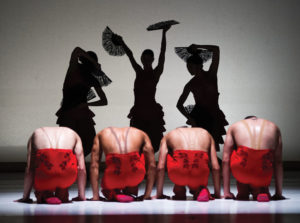Ballet Hispánico: Lopez Ochoa / Línea Recta, Manzanales / Con Brazos Abiertos, Pérez-Salas / 3. Catorce Dieciséis - Vancouver Ballet Society
- Home
- Reviews 2014 - 2019
- Ballet Hispánico: Lopez Ochoa / Línea Recta, Manzanales / Con Brazos Abiertos, Pérez-Salas / 3. Catorce Dieciséis

Even without a playbill, it may have been possible to pick up on the fact that all three pieces in the terrific program presented by Ballet Hispánico in Victoria, B.C., in April were created by women. The evening just felt a little different. Throughout, women were central, but not as male-gaze objects of desire. There were none of the usual love stories, no battles between the sexes or conflicts between males striving for dominance. Women and men were equal.
Annabelle Lopez Ochoa’s Línea Recta (2016) opened the show with Eila Valls barefoot onstage in brilliant red, her back to the audience, a long, frilly cola (train) spread out behind her. She began to move in ways familiar from traditional flamenco: arms above the head, wrists cocked, hands twirling, torso contained. Soon though, her proud carriage melted, her body became fluid and her train became a toy for her to play with. It wrapped around her neck, roiled around her arms.
When four men arrived, the train moved between and around the dancers as, in Ochoa’s unusual take on flamenco, the performers actually danced with and touched each other, doing away with the usual oblique, war-like challenge, where the dancers circle each other from afar. In the following segments (marred slightly by the stop/start transitions between them), four women –– in red still, but with abbreviated trains –– joined the men in what is both a tribute to the passion of flamenco and a reimagining of it as a dance of partnership.
In the satirically titled Con Brazos Abiertos (With open arms), dancer Diana Winfree stood in for Mexican-American choreographer Michelle Manzanales, who uses the 2017 work to comment on her own life as someone caught between two cultures: not Mexican enough for the Mexicans, not American enough for the Americans. Like Línea Recta, this piece involves multiple segments that often seem to have nothing to do with each other. Full-company dances of great joy — where men and women alike whirled in iconic Mexican embroidered trousers and giant sombreros, or took over the stage in extra-long white skirts and spun until the space felt overflowing with fabric –– alternated with poignant, quiet pieces, highlighting Winfree’s long limbs, control and stillness.
As the group sombrero dance ended, Winfree appeared alone on the stage holding her own, plainer version of the famous hat. Now, though, the sombrero is not a thing of joy; rather, it is a symbol of what she wants to both embrace and separate from. She rarely lost contact with the hat: it balanced on her hands, her neck, her arms, her legs. She even tried to climb inside it.
Toward the end, she tossed it in the air, only to have it come back and land over her heart. Later, she danced with Lyvan Verdecia to Radiohead’s Creep (“What the hell am I doing here? I don’t belong here.”). Verdecia and Winfree were not at ease with each other at first. She nudged him to move, but it took time for him to respond. Eventually, though, they found a way to work together. He lifted her; she lifted him. To call it hope for the future may be too much, but wouldn’t it be nice?
The wildly varied moods of Con Brazos Abiertos –– reflected in a soundscape that includes a snippet from Cheech and Chong, a reading by actor Edward James Olmos, and a popular Mexican song from the 1940s sung by Julio Iglesias –– sound incompatible, but Manzanales wove them with such intelligence and skill that the funny and the sad, the boisterous and the quiet, make a whole cloth.
Tina Ramirez founded Ballet Hispánico 48 years ago in Manhattan to give Latin choreographers and dancers a voice. Often, as with the two previous pieces, commissioned by current artistic director Eduardo Vilaro, that has meant presenting dances with recognizably Latin movement styles or addressing Latin cultural issues. But not always. The final piece, 3. Catorce Dieciséis by Tania Pérez-Salas, is Latin only by virtue of its creator’s Mexican heritage. Built around the idea of the unending number pi (3.1416), this 2002 work makes no references to Hispanic culture and uses no recognizably Latin movement. Instead, it would fit in any contemporary ballet company’s repertoire — but they would have to be able to perform it as well as these dancers.
3. Catorce Dieciséis showcased the company’s technique and was the most artistically integrated work on the program. Set to music by Vivaldi and other Baroque composers, the piece moved seamlessly through a series of scenes as through a kaleidoscope: the colours and moods shifting but ever moving forward. Quick, sharp movements, unexpected flexes of the feet and undulations of the back and chest, brought out the astringent quality in the music, making it sound thoroughly up to date. Unlike the others, this piece is not meant to be fun, yet as a picture of the human condition — keep moving or die –– it was beautiful.
— ROBIN J. MILLER
DI SUMMER 2018

